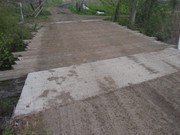Silver
Well-known member
It was a chore, but got it done. All new wood from the I-beam up. Treated 4 x 6 underneath, rough 3x12's on top. Tomorrow I will dig out the abutments and install some oak mats I salvaged to act as an abutment wall. Should be good for another 30 years I hope.





